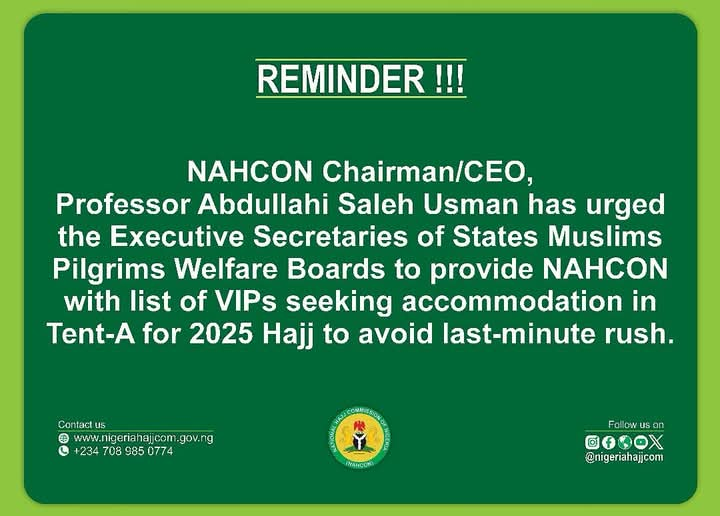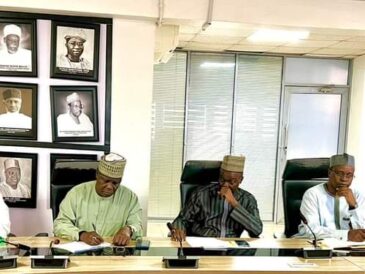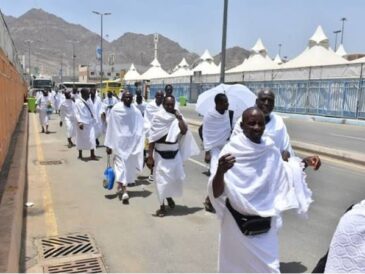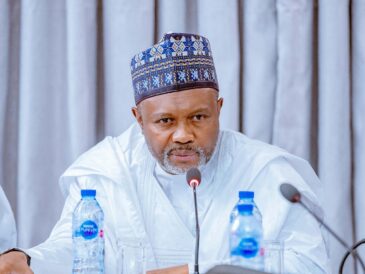![]()
The ongoing pilgrim’s registration is witnessing the lowest level of response in the history of hajj seat reservation in Nigeria owing to the N8.4 million deposit benchmarks announced by state Muslim Pilgrims Welfare Boards across the country. The incremental increase in the hajj fare has also affected the will and zeal of average Nigerian Muslims to pick up interest in the hajj.
The yearly increase in Hajj fare calls for outside-the-box solutions that require a serious commitment from Hajj administrators and service providers. The rise in Hajj fare affects all Hajj participating countries without exceptions.

Other countries have come out with innovative policies to reduce the impact of increase on their pilgrims and it is the right time to adopt a new approach towards addressing this issue. Pakistan has rolled out hajj fares based on the accommodation location and allows its citizens abroad to pay for hajj fares in dollars. Malaysia has signed three-year airlift agreements to lower hajj packages. Tambug Hajji has subsidized hajj packages for its pilgrims.
Commendably, NAHCON Chairman, Professor Usman Abdullahi Saleh is focusing on how to reduce the hajj fare and has so far initiated some experimental measures that may make the 2025 hajj fare less than 2024.

However, the first step to achieve this objective is to negotiate the cost of hajj services with service providers based on the interest of pilgrims alone. I am not saying that other interests are being embedded in previous negotiations but I understand that It is difficult to treat an ailment if you don’t undergo the right diagnosis.
Technically, the three constant factors that influence hajj fare are the Exchange rates, the numbers and cost of services rendered to pilgrims in Saudi Arabia and the number of days Nigerian pilgrims spend in Saudi during hajj.
Unfortunately, NAHCON has no control over the forex rate, it can only negotiate on the price of services and has limited influence on the number of days pilgrims spend in Makkah. The number of days is indirectly dictated by the Saudi Arabia General Civil Aviation Authority GACA regulations guiding the airlift of pilgrims from hajj countries.
The GACA rules under Flight Slots stated that ‘Flight operators must obtain flight slots for both inbound and outbound phases, and distribute them equally over 30 days.
Under Housing contracts, the rules also stated that “Flight operators must present their flight schedule to the Hajj missions of the state they are transporting to so that they can sign housing contracts with the pilgrims.
Under rule 2c, Flights of more than 30,000 pilgrims shall be distributed over 30 days for each phase. Flights of pilgrims numbering from 20,000 to 30,000 shall be distributed over 25 days for each phase.
Flights of pilgrims numbering from 10,000 to 20,000 pilgrims shall be distributed over Eighteen days for each phase.
“All airlines operating Hajj flights shall distribute and schedule their flights as indicated in item No. (2-c) herein above in a balanced manner in such a way that ensures the best utilization of the entire period. Meantime, their flight schedules should not be intensified during the last week of the inbound phase and the prime week of the outbound week. Due diligence shall be exercised in allocating the daily flights to be spread over broad intervals of time.
This is the major reason why Private Hajj Operators can organize a package of 2 weeks or 20 days while the state Pilgrims fall in the category of 30 days.
The implications of the 30-day airlift spread for Nigeria with 95,000 seat allocation is that the first batch that arrived in Saudi Arabia must spend a minimum of 30 days likewise the last batch.
Outside-the-box experiments
Therefore, NAHCON should start innovating and creating alternative hajj packages differently from the three categories that have been in place for decades. The existing hajj fare lists are the States Muslim Pilgrims Welfare Boards package and the Private Hajj Operators twin Packages that consist of medium and VIP services.
In the past, the hajj packages from States Muslim Pilgrims Welfare Boards are split into three categories. The minimum with 750-dollar BTA, the medium with N1,000 BTA and the maximum with N1,500-dollar BTA.
It is time to introduce alternative packages for States Muslim Pilgrims like two or three different categories. We can reintroduce different packages based on Basic Travelling Allowances BTA and number of days to be spent in Makkah. This will give State pilgrims an option to choose from.
The proffers include Hajj fare with no BTA, Hajj fare with $300 US dollar BTA, Hajj fare with $500 BTA and Hajj fare with $800 US dollar BTA. Another alternative is to have a package that comes with spending fewer numbers of days in Saudi Arabia without obstructing Saudi Arabia’s General Authority of Civil Aviation GACA rules and regulations governing the Airlift of Pilgrims.
Starting this year, NAHCON can tap from the long-term service contracts approved by the Saudi Arabia Ministry of Hajj and Umrah. Accommodation contracts rate should be based on closeness to Haram and negotiated on a long-term basis. NAHCON can use the 3 years retainership bargain with caterers to cut down feeding costs.
For example, if caterers charge 50 Saudi Riyals per plate, they can be told to reduce it to 35 Saudi Riyals for 3-year retainership contracts. The same formular can be applied for accommodation in Makkah and Madinah. The deregulations of Saudi hajj service providers opened the way for competition and we should make the hay while the competition lasts.
Additionally, signing 3-year contracts with service providers will lower the price of services and also address issues of instability in the Hajj Industry. The root cause of squabble in Nigeria’s Hajj Industry can be linked to the yearly signing of contracts with service providers.
To achieve this, NAHCON can constitute a committee comprised of experienced hajj administrators and veterans to brainstorm the appropriate on strategies.
Admittedly, the Hajj Saving Scheme has the potential of lowering financial pressure on both Hajj institutions and intending pilgrims but our toxic peculiar internal structure and ever-living doctrine of “what is in for me” may not allow HSS to be implemented without drawbacks.
The onshore service payments like pilgrims’ suitcases, Uniforms, Yellow Cards, service charges payable to NAHCON and state Muslim Pilgrims Welfare Boards, development levy and the newly introduced security charges being paid to state Muslim Pilgrims Welfare Boards need to be reviewed.
NAHCON should abolish the yearly renewal of operational licenses for Private Hajj and Umrah Operators and allow their operational licenses to have a 3-year Hajj/Umrah life span. This will reduce the number of activities in the Hajj calendar and also allow Hajj and Umrah Operators to map out a long-term Hajj plan which will reduce the cost of private Hajj packages.
We can begin by experimenting with short-stay options with separate hajj fares and low-service hajj packages
For example, 15 to 20 per cent of the State’s Hajj seats can be used as experiments where interested pilgrims will opt for a short stay and a lower Hajj service.
The short-stay options can come without a provision for feeding in Makkah and Madina. The period of stay in Madina can be shortened to two days while they will be allowed to use their luggage thereby reducing the cost of luggage. No uniform except NAHCON designed Identification Cards showing that they are “short stay passengers. Such lower packages can be reserved for repeaters who already have experience in Hajj.
A separate airline can be assigned to airlift the short-stay pilgrims with departing points in Zones as opposed to state-by-state airlift arrangements. Their airlift can begin 12 days to Arafat and the return leg fixed at 6 days after Hajj days to lower accommodation fees.
Lastly, Hajj stakeholders can plead with the Federal Government to enter into a currency swap deal with Saudi Arabia for the sake of the Hajj exercise. Such an agreement will factor the quantum of hajj transactions for 95,000 seat allocation yearly thereby making it possible to pay for services in naira under such a naira vs Saudi Riyal swap deal.
Recently, Nigeria and China renewed a 15-billion-yuan ($2 billion) currency-swap arrangement designed to boost trade and investment between the two countries. The agreement is valid for three years and can be renewed upon mutual consent,”
Indeed, reducing hajj fare will require outside-the-box options.
*Ibrahim Muhammad
National Coordinator
Independent Hajj Reporters





